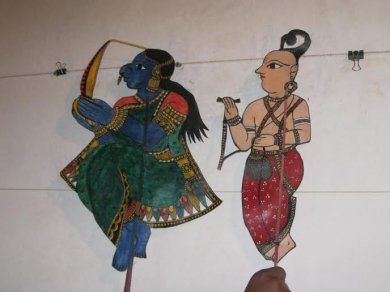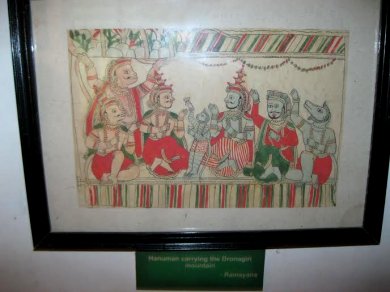
|
 |

|
 |
Kalasutri Bahuliya: A dying puppetry art of Maharashtra Text & pics: Charanya Gurusathya e-mail: charsathya@gmail.com September 6, 2015 Since the days of remote past, rich traditional heritage of arts and culture in India have continued to prove their creative magnificence. With the passage of time and advent of globalization, we have witnessed the emergence of a consistent macro-culture. Under the influence of such a voracious macro-culture the arts and culture of our country is suffering from attrition and erosion. The development of art and cultural organizations has been closely related to government policy to create an environment that is more favorable to arts, artists and cultural development. Puppetry is a very ancient art form that originated about 3000 years ago. Natya Shastra by Bharatamuni in the second century brings much evidence on puppets. The producer-cum-director of the human theatre has been termed as 'Sutradhar' meaning the holder of strings. Puppets have been used since the earliest times to animate and communicate the ideas and needs of human societies. Although puppets have been employed by various disciplines and community, little has been written about their use as a communication tool in research. A qualitative research study on string puppets of Maharashtra is conducted to explore the origin and history of puppetry, to revive the art and to explain how and why traditional art forms continue to have educational efficacy for contemporary developmental projects.  Kalasutri Bahuliya has its origin in 1600 A.D. Also known as Zaiti, it is a Marathi folk form, immensely popular till the twentieth century - 'Kal' meaning forefingers of human hand, 'Sutri' meaning black thread and 'Bahuliya' meaning puppets. This is a small wooden puppet with moveable arms and shoulder joints. References to these puppets are found in ancient texts and saint poetry. The Kalasutri puppets are mentioned in the 15th chapter of the famous and sacred Gyaneshwari written by Sant Gyaneshwar. Vishnudas Bhave, the pioneer of modern Marathi theatre, is known to have begun his career with puppet shows that he called Yamapuri. This means 'City of Yama' and this is named after the God of Death. Today they have become almost obsolete, and found only among some tribes like the Thakar in parts of Maharashtra.  Culture Aangan, a social enterprise involved in preservation of art and culture, traditional customs, intervened to preserve the dying arts. On 26th July 2005, the Culture Aangan team met Parshuram Gangavane for the first time and was inspired by his sincere effort to save the dying art and agreed to help him set up the art village in Pinguli. Together with artists and Parshuram Gangavane, Culture Aangan helped tribes set up the Thakar Aadiwasi Kala Aangan Museum and guided them in organizing activities like puppet shows and other art forms for tourists. Parshuram Atmaram Gangavane is a passionate puppeteer who learnt the folk art from his father and uncles and has vowed to keep the 400-year-old ancestral heritage alive.  The puppets are carved from the lightwood of pangara that is the coral tree. The themes presented in a Kalasutri Bahuliya theatre are usually based on two epics, Ramayana and Mahabharata. The scenes from Krishna Puran are also performed, most common being the Dashavataram and Bhagawad Gita Upadesham. It is always performed with live folk music. Traditional puppeteers are experts who learn techniques from their forefathers and are well aware of the technique of manipulating these puppets. The ancient village of Pinguli in the Konkan region of Maharashtra has been home for nearly five hundred years to a wide variety of ritual performance arts. The Thakar community is currently able to perform the following traditional Thakar arts.
Due to the lack of support and the pressures of modernity in the region these invaluable heritage is in risk of disappearance. "In the past, puppet shows had keen patrons in the royalty while today there are no patrons, with most viewers turning to the modern modes of entertainment. The television does not demand any level of literacy from its viewers while in the past a crowd who at least knew their Ramayana by ear enjoyed the puppet show. Some six years ago, a collector tried to set up an institute to develop the tradition but that did not work out as none in the village was prepared to part with six acres of land. Today, the younger generation is not keen as otherwise I am prepared to pass on my know-how," admits Gangavane. The roots of puppetry lie in the Natya Shastra and they have many similarities to other art forms in their technical design, crafting, movements, ornamentation and attire. Puppetry shares commonalities in presentation, vocal and instrumental music, costume and the geographical definition of the stage. Today we hardly see the traditional formal structure in puppetry, whether it is the stories told, or the kind of ornamentation. It is the need of the hour to determine structure to puppetry as well and revive it back to its traditional form as in earlier times and continue the age-old tradition of storytelling about our rich heritage to the masses skillfully. Charanya Gurusathya, artistic director of Natyashala School of Bharatanatyam, has been teaching Bharatanatyam for the past five years at Baner, Pune. This article contains excerpts from her thesis submitted from her research during her Masters in Fine Arts. Post your comments Please provide your name and email id when you use the Anonymous profile in the blog to post a comment. All appropriate comments posted with name & email id in the blog will also be featured in the site. |